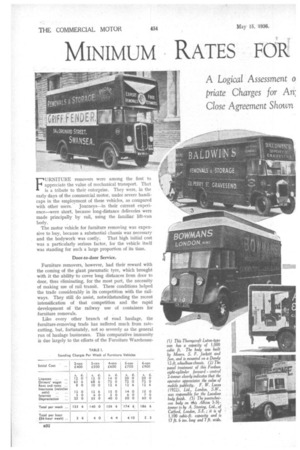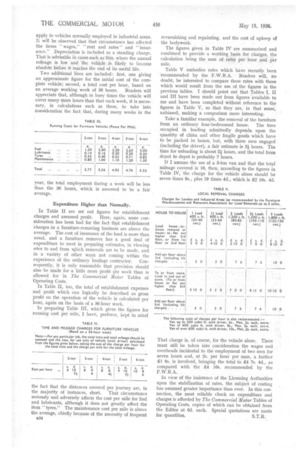MINIMUM• RATES FOR FURNITURE REMOVING
Page 50

Page 51

Page 52

If you've noticed an error in this article please click here to report it so we can fix it.
A Logical Assessment o priate Charges for An: Close Agreement Shown t Basis on which Approlob Can be Calculated. Rates of the F.W.R.A.
FURNITURE removers were among the first to appreciate the value of mechanical transport. That is a tribute to their enterprise. They were, in the early days of the commercial motor, under severe handicaps in the employment of these vehicles, as compared with other users. Journeys—in their current experience—were short, because long-distance deliveries were made principally by rail, using the familiar lift-van
body. .
The motor vehicle for furniture removing was expensive to buy, because a substantial chassis was necessary and the bodywork was costly. That high initial cost was a particularly serious factor, for the vehicle itself was standing for such a large proportion of its time.
Door-to-door Service.
Furniture removers, however, had their reward with the coming of the giant pneumatic tyre, which brought with it the ability to cover long distances from door to door, thus eliminating, for the most part, the necessity of making use of rail transit. These conditions helped the trade considerably in its competition with the railways. They still do assist, notwithstanding the recent intensification of that competition and the rapid development of the railway use of containers for furniture removals.
Like every other branch of road haulage, the furniture-removing trade has suffered much from ratecutting, but, fortunately, not so severely as the general run of haulage businesses. This comparative immunity is due largely to the efforts of the Furniture Warehouse men and Removers Association and, to some extent, to the fact that it is a specialized trade, requiring a particular type of vehicle and expert labour.
The part-time removers obtain only the poorest types of load; all better-class removals fall, naturally, to the lot of properly equipped specialists. The trade, therefore, has always been, to some extent, a closed ring. Even so, there has not been countrywide agreement about rates. Lack of standardization has arisen from the same cause, which has brought about similar differences of opinion as regards appropriate rates for other kinds of haulage. The cause is incomplete knowledge of the cost of operating the vehicle and of additional contingent expenses.
Special Costing Methods Needed.
I have already pointed out that the business of furniture removal is a special branch of haulage; it is peculiar even as regards the cost of operation and as to the method of setting out costs as a preliminary to calculating minimum profitable rates.
The accompanying tables indicate how cost of operation should be assessed for this trade. They should be perused carefully in conjunction with the subsequent
notes concerning them. Particularly is it important that they should be compared with the corresponding figures for ordinary haulage as set out in The Commercial Motor Tables of Operating Costs.
In Table I are listed the standing charges per week of furniture vehicles having a nominal load capacity of 2 tons to 6 tons inclusive. The data given differ in two principal aspects from those in The Commercial Motor Tables.
In the first place, the figures quoted are intended to apply to vehicles normally employed in industrial areas. It will be observed that that circumstance has affected the items "wages," "rent and rates" and "insurance." Depreciation is included as a standing charge. That is advisable in cases such as this, where the annual mileage is low and the vehicle is likely to become obsolete before it reaches the end of its useful life.
Two additional lines are included : first, one giving an approximate figure for the initial cost of the complete vehicle; second, a total cost per hour, based on an average working week of 36 hours. Readers will appreciate that, although in busy times the vehicle will cover many more hours than that each week, it is necessary, in calculations such as these, to take into consideration the fact that, during many weeks in the year, the total employment during a week will be less than the 36 hours, which is assumed to be a fair average.
Expenditure Higher than Normally.
In Table II are set out figures for establishment charges and assumed profit. Here, again, some consideration has been had for the fact that establishment charges in a furniture-removing business are above the average. The cost of insurance of the load is more than usual, and a furniture remover has a good deal of expenditure to meet in preparing estimates, in viewing sites to and from nhich removals are to be made, and in a variety of other ways not coming within the experience of the ordinary haulage contractor. Consequently, it is only reasonable that provision should also be made for a little more profit per week than is allowed for in The Commercial Motor Tables of "Operating Costs.
In Table II, too, the total of establishment expenses and profit which can logically be described as gross profit on the operation of the vehicle is calculated per hour, again on the basis of a 36-hour week.
In preparing Table III, which gives the figures for running cost per mile, I have", perforce, kept in mind
TIME AND MILEAGE CHARGES FOR FURNITURE VEHICLES (Based on a 36-hour week) Note :-For any particular job, the total time and total mileage should be asseued and the rate, for use only of vehicle (with driver) calculated from the figures given below, taking the sum of the charge per hour for the total time and the charge per mile for the total mileage,
the fact that the distances covered per journey are, in the majority of instances, short. That circumstance seriously and adversely affects the cost per mile for fuel and lubricants, although it does not greatly affect the item "tyres." The maintenance cost per mile is above the average, chiefly because of the necessity of frequent 934 revamishing and repainting, and the cost of upkeep of the bodywork.
The figures given in Table IV are summarized and combined to provide a working basis for charges, the calculation being the sum of rates per hour and per mile.
Table V embodies rates which have recently been recommended by the F.W.R.A. Readers will, no doubt, be interested to compare these rates with those which would result from the use of the figures in the previous tables. I should point out that Tables I, II and III have been made out from figures available to me and have been completed without reference to the figures in Table V, so that they are, in that sense, unbiased, making a comparison more interesting.
Take a familiar example, the removal of the furniture from an ordinary four-bedroomed house. The time occupied in loading admittedly depends upon the quantity of china and other fragile goods which have to be packed in boxes, but, with three men engaged (including the driver), a fair estimate is 34 hours. The time for unloading is about 24 hours, and the total from depot to depot is probably 7 hours.
If I assume the use of a 3-ton van and that the total mileage covered is 10, then, according to the figures in Table IV, the charge for the vehicle alone should be seven times 8s., plus 10 times 4d., which is £2 19s. 4d.
That charge is, of course, for the vehicle alone. There must still be taken into condderation the wages and overheads incidental to the employment of two men for seven hours and, at 2s. per hour per man, a further £1 8s. is involved, bringing the total to £4 7s. 4d., as compared with the £4 10s. recommended by the F. W. R. A .
In view of the insistence of the Licensing Authorities upon the stabilization of rates, the subject of costing has assumed greater importance than ever. In this connection, the most reliable check on expenditure and charges is afforded by The Commercial Motor Tables of Operating Costs, copies of which can be obtained from the Editor at 6d. each. Special quotations are made for quantities. S.T.R.




































































































